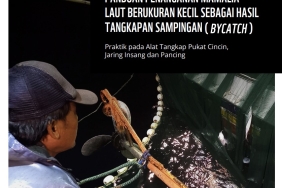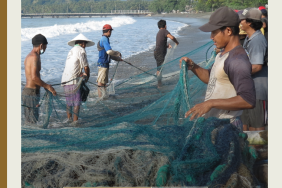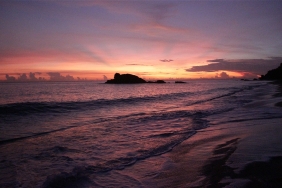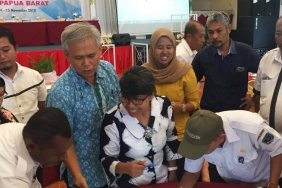SEAWEED SCHOOL I, HELPS FARMERS UNDERSTAND INDONESIAN SEAWEED BUSINESS
Author: Faridz Rizal Fachri (Fisheries Business Officer WWF-Indonesia)
The uncertainty of seaweed prices that continues to occur with a significant price difference, has had an impact on the confidence of seaweed farmers to be consistent in cultivating. The price pressure, which has not been able to fulfill their living needs, requires them to look for other income.
This condition is exacerbated by the attack of ice-ice disease, which according to the cultivators has been going on for approximately the last 10 months in the waters of Hoat Island, Nai Island, and most other locations in Southeast Maluku waters. This resulted in most of the cultivators returning to land, while only 33% of the cultivators remained and actively carried out seaweed cultivation activities, which was followed by a decrease in seaweed productivity from Southeast Maluku Regency.
With its designation as a Marine Protected Area and Small Islands, Small Kei Island, Islands and Surrounding Waters in early February 2016, Southeast Maluku Regency is expected to have a major impact on the welfare of the community. However, the emergence of ice-ice disease on seaweed in most areas of this district requires more attention from the management and local government to analyze what is actually happening to the condition of the waters.
A study on disease observation and seaweed growth has actually been carried out jointly between the "Penyu Lestari" Seaweed Farmers Group on Hoat-Nai Island, Ohoi Debut, WWF-Indonesia, and a number of academics. The study identified Lampung's tissue culture seaweed varieties as having better resistance to disease with constant growth (tripling within 25-30 days).
In addition, from the joint research, local farmers have understood the factors that cause disease and understand research methods, so that in the future they can analyze the condition of seaweed independently.
Another problem that needs to be followed up is the availability of seedlings that are depleted due to disease attacks through the Aquaculture Improvement Program (AIP) scheme for Kotoni seaweed, namely by encouraging the existence of seedling farms managed by groups through the use of recommended research seeds.
Group seedling procurement capital receives village support from the Ohoi-Owned Business Enterprise (BUMO) or Village-Owned Business Enterprise (BUMDes) funds, according to the needs of each cultivator and is carried out collectively by the group. This is one of the potentials that is worth planning and utilizing effectively.
In order to increase the motivation of the farmers, it is important to increase their knowledge of the actual condition of the seaweed business in Indonesia. The group of farmers in Hoat-Nai Island and Ohoi Wab Arso had a very good opportunity to have an intense discussion about the seaweed business in Indonesia and opportunities for cooperation with PT Bantimurung Indah (Makassar), on September 6-7, 2016.
The discussion entitled Seaweed School I was organized by WWF-Indonesia and PT Bantimurung Indah in Hoat Island, Ohoi Debut, and attended by a number of WWF-Indonesia assisted cultivator communities in Southeast Maluku.
Most farmers think that the higher the price, the better for them. However, it is also necessary to consider the market's role in it, which is certainly carried out by middlemen to fulfill their needs.
Agus Salim, the head of PT Bantimurung, assured the farmers that the most important thing in the seaweed business is the creation of a constant price that is not always high but prioritizes a fixed price and cuts the supply chain to slightly boost the existing price.
Moreover, the Chinese market, which keeps production costs as low as possible for the effectiveness of their seaweed processing production, has an impact on the price dynamics in Indonesia. Sustainability, consistency and organization of production is actually the key for farmers to be able to manage their income from this seaweed commodity sector.
The industry is very interested in the quality of seaweed from Southeast Maluku, which can be seen from the content of gell strange reaching 900 gr/cm2, compared to seaweed from other Maluku areas which is only around 700 gr/cm2. With its white and clean processed condition (the international market calls it 'light' quality), Southeast Maluku seaweed has potential competitiveness. This potential is certainly maintained by encouraging cooperation between the private sector and the community.
Another potential that can be supported is the operation of a seaweed processing plant in Southeast Maluku that has not been functioning properly. It is believed that all the problems of cultivators can be solved completely by processing raw materials directly at the local level. The communication that has been established between the farmers and the local government has received a good response, but it must still be maintained and monitored in relation to the follow-up process.
In addition to the role of the market, it is also important to improve the quality and capacity of the group to become a strong community for the sustainability of their livelihoods, both in terms of environmental friendliness and also in terms of livelihoods for them.





